TNT Designs Jewels
TNT Design Jewels – A Beloved San Clemente Artisan of Unique, Handcrafted Jewelry.
TNT Designs Jewels
TNT Design Jewels – A Beloved San Clemente Artisan of Unique, Handcrafted Jewelry.
📍 TNT Designs Jewels
San Clemente's
From the Heart of San Clemente’s Farmers Market : TNT Designs Jewels Creates Jewelry That Tells a Story
📍 TNT Designs Jewels
San Clemente's
From the Heart of San Clemente’s Farmers Market : TNT Designs Jewels Creates Jewelry That Tells a Story
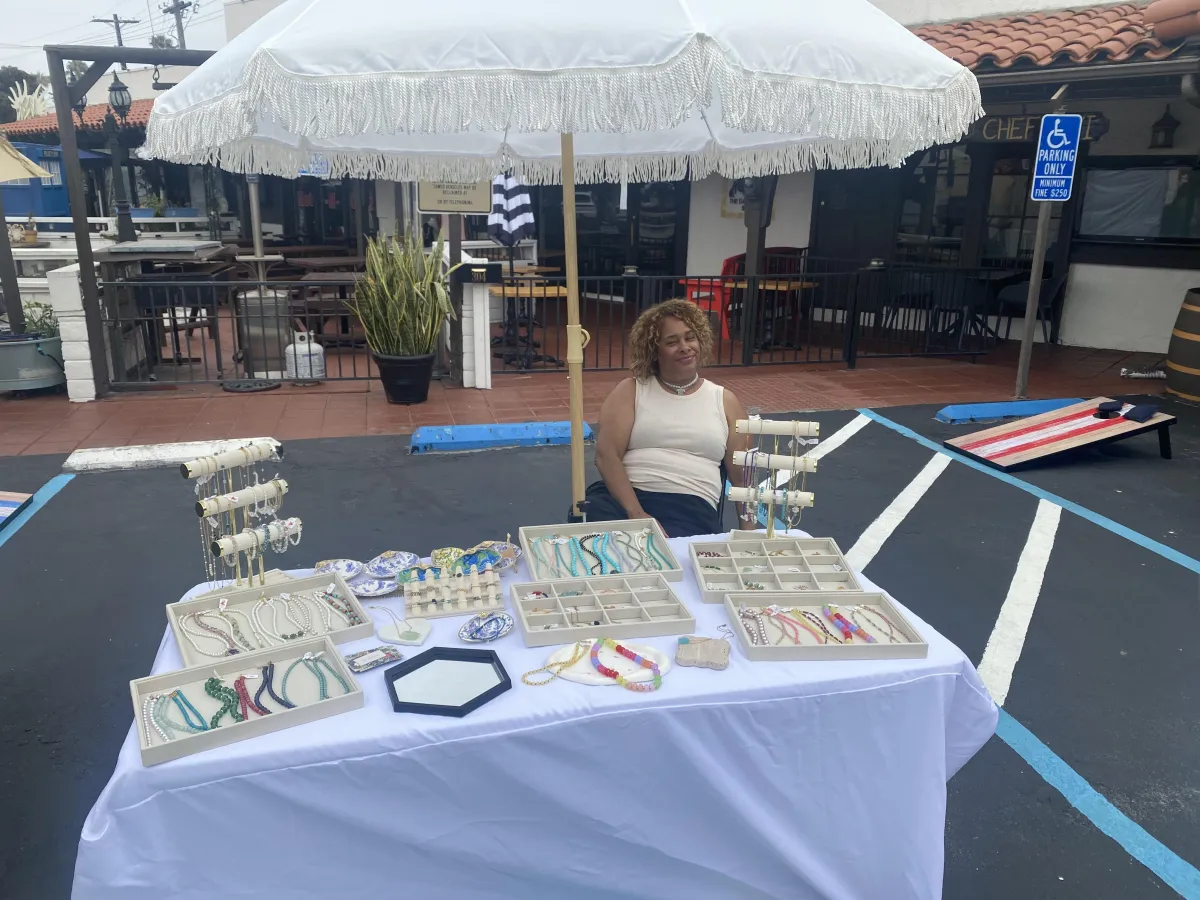
Parking Details
All About TNT Designs Jewels
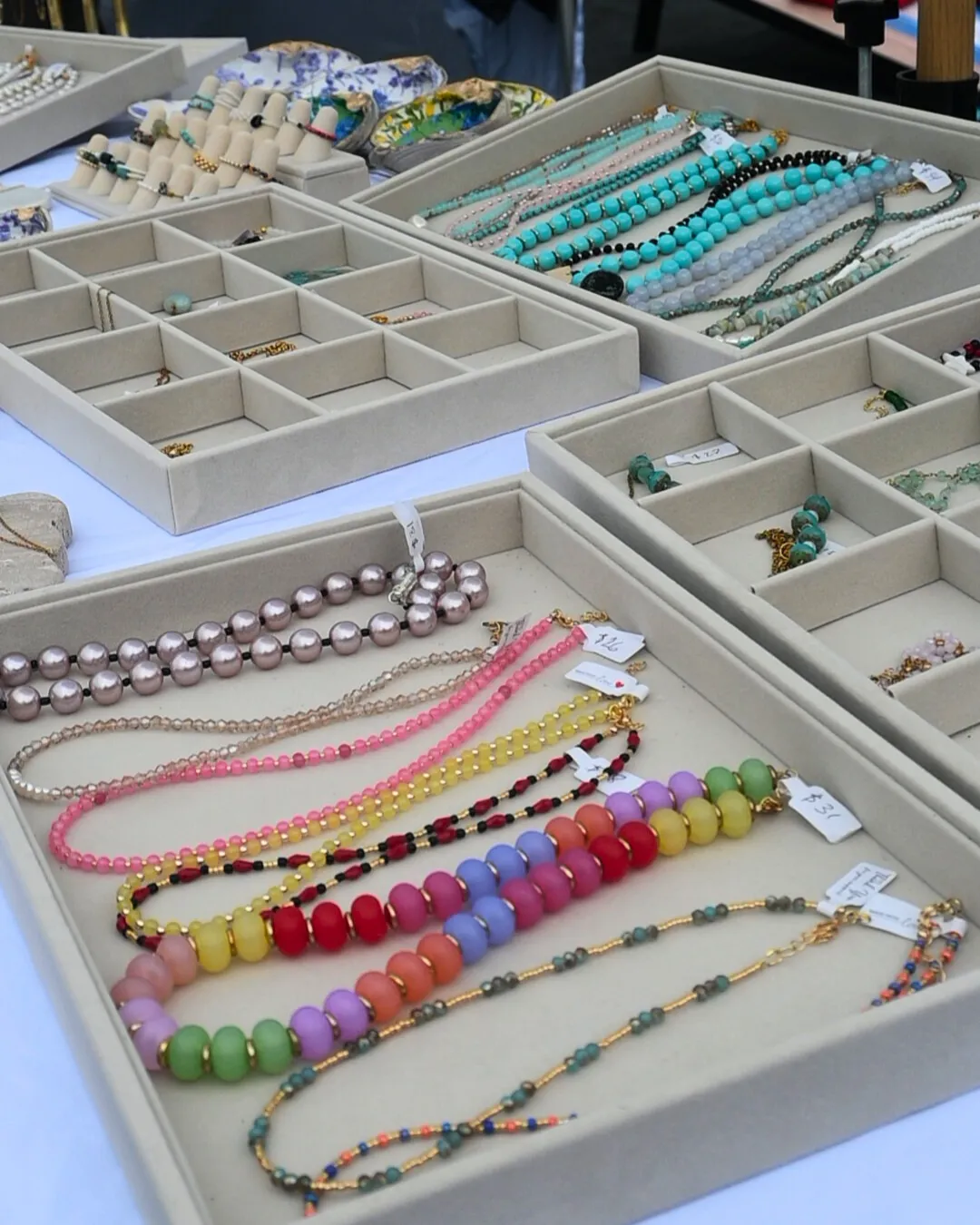
OUR STORY:
TNT Designs was started by Tayna, a mother and wife who strives to make beautiful unique jewelry for everyone. Her pieces are handcrafted entirely by hand and made to be one of a kind for whoever wears them.
TNT Jewelry creates handcrafted, one-of-a-kind pieces that celebrate the natural beauty and healing energy of the earth. Each necklace, bracelet, and pair of earrings is thoughtfully designed using ethically sourced crystals, gemstones, and artisan-quality beads, ensuring every piece carries both artistry and meaning.
Our process is slow and intentional—**every bead is chosen by hand**, every crystal wrapped with care—to highlight the unique colors, textures, and spiritual properties of each stone. From soothing amethyst and grounding jasper to radiant quartz and joyful citrine, our collections are designed to inspire balance, self-expression, and everyday elegance.
With a style that blends bohemian charm and modern simplicity, TNT Jewelry is perfect for those who seek beauty with purpose—pieces that are not only stunning to wear but also infused with positive energy and timeless craftsmanship.
---
OUR STORY:
TNT Designs was started by Tayna, a mother and wife who strives to make beautiful unique jewelry for everyone. Her pieces are handcrafted entirely by hand and made to be one of a kind for whoever wears them.
TNT Jewelry creates handcrafted, one-of-a-kind pieces that celebrate the natural beauty and healing energy of the earth. Each necklace, bracelet, and pair of earrings is thoughtfully designed using ethically sourced crystals, gemstones, and artisan-quality beads, ensuring every piece carries both artistry and meaning.
Our process is slow and intentional—**every bead is chosen by hand**, every crystal wrapped with care—to highlight the unique colors, textures, and spiritual properties of each stone. From soothing amethyst and grounding jasper to radiant quartz and joyful citrine, our collections are designed to inspire balance, self-expression, and everyday elegance.
With a style that blends bohemian charm and modern simplicity, TNT Jewelry is perfect for those who seek beauty with purpose—pieces that are not only stunning to wear but also infused with positive energy and timeless craftsmanship.
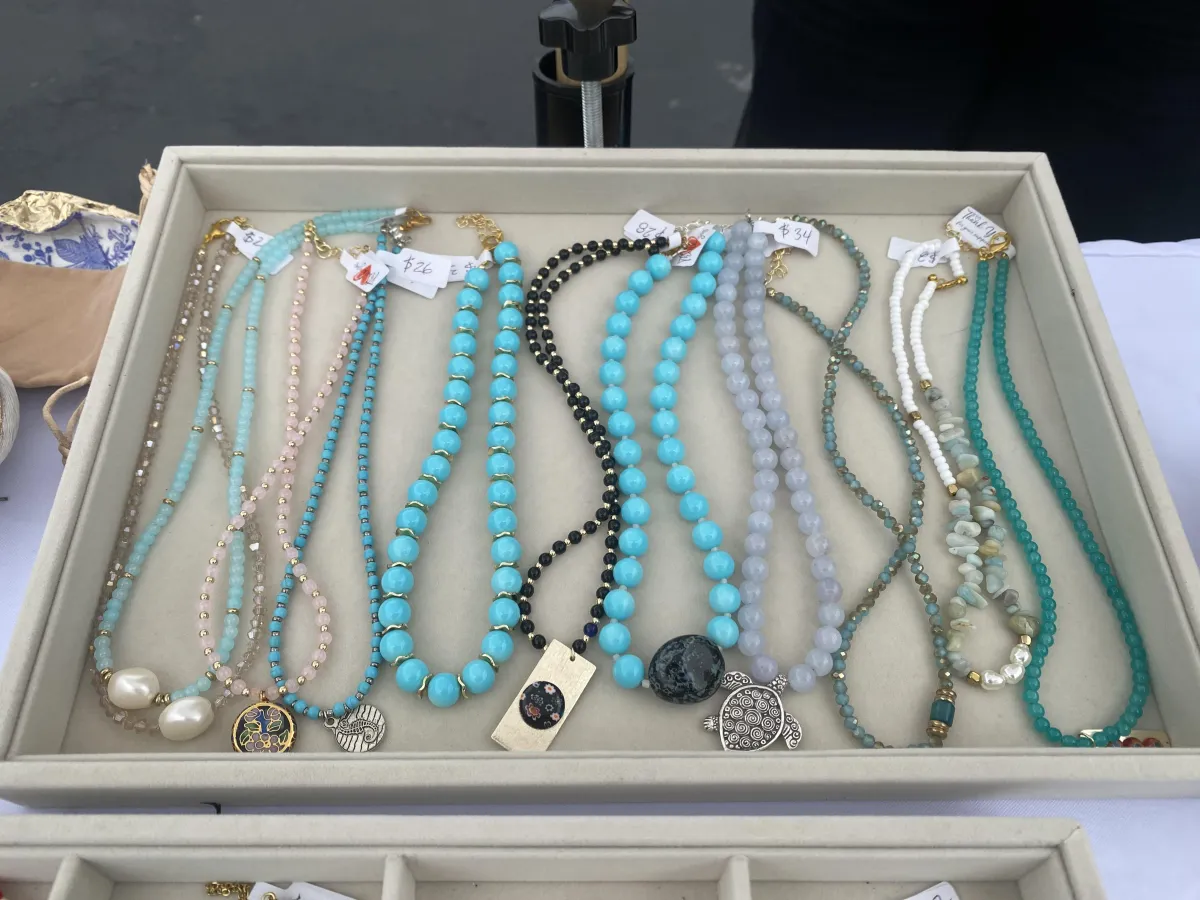
TNT Designs offers a wide variety of jewelry from semiprecious stones, to crystals, seashell material and abalone. Her vast range of jewelry has something for everyone. Gold and silver options are available as well as earrings, bracelets, rings, necklaces, and homemade seashell dishes to put jewelry in. Come by and see for yourself!
Market Hours
🗓️ Every Second Saturday of the Month
🕖 10:00 AM – 2:00 PM
TNT Designs offers a wide variety of jewelry from semiprecious stones, to crystals, seashell material and abalone. Her vast range of jewelry has something for everyone. Gold and silver options are available as well as earrings, bracelets, rings, necklaces, and homemade seashell dishes to put jewelry in. Come by and see for yourself!
How to Buy and Contact Us when we are not at the Old Town Market
If Looking for timeless, handcrafted jewelry? Contact TNT Design Jewels at (602) 402-5140 or [email protected]
VISIT US AT THE: Old Town Market
🗓️ Every Second Saturday of the Month
🕖 10:00 AM – 2:00 PM
LOCATION: Old Town San Clemente, 111 W. Avenida Palizada, San Clemente, CA 92672
EXPLORE THE BEAUTY OF UNIQUE, HANDMADE DESIGNS
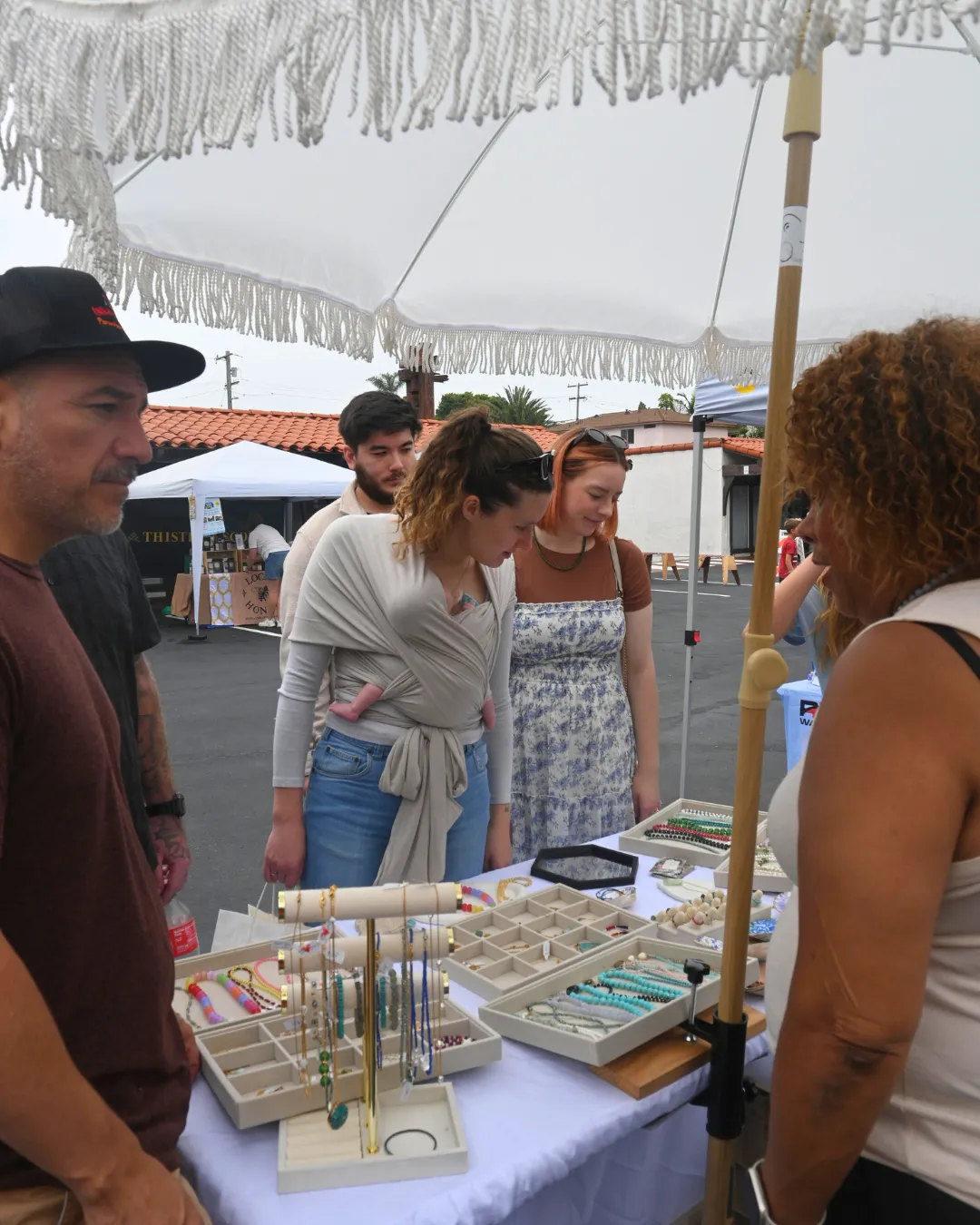
---
Jewellery
Jewellery (or jewelry in American English) consists of decorative items worn for personal adornment, such as brooches, rings, necklaces, earrings, pendants, bracelets, and cufflinks. Jewellery may be attached to the body or to clothing. In a Western context, the term usually refers to durable ornaments, and excludes ephemeral items such as flowers.
For many centuries, gold and silver, often combined with gemstones, have been the predominant materials for jewellery. Other materials, including glass, shells, and wood, have also been used.
History
Jewellery is among the oldest forms of archaeological artefacts, with Nassarius shell beads dating back approximately 100,000 years considered the earliest known jewellery.
Basic jewellery forms vary across cultures but have shown remarkable continuity. In European traditions, familiar types such as rings and necklaces have persisted since antiquity, while forms like nose or ankle adornments—common elsewhere—are less frequent.
Materials and Symbolism
Jewellery has been made from a wide range of materials, including gemstones and other natural substances such as amber and coral, precious metals, beads, and enamel. In most cultures, jewellery functions as a status symbol, valued for its materials, patterns, or symbolic meaning.
It has been used to adorn nearly every body part, from hairpins to toe rings, and even genital jewellery. In modern European cultures, the amount worn by adult males is relatively modest compared with both other cultures and earlier European eras. Jewellery that is worn continuously or is difficult to remove is sometimes described as permanent jewellery.
---
Gemstones
A gemstone—also known as a fine gem, jewel, precious stone, or semiprecious stone—is a piece of mineral crystal that has been cut or polished for use in jewellery or other decorative items.
Certain rocks, such as lapis lazuli, opal, and obsidian, and some organic materials including amber, jet, and pearl, are also commonly regarded as gemstones.
Properties and Uses
Most gemstones are hard minerals, but some softer minerals (for example, brazilianite) are occasionally used for their distinctive color, luster, or other aesthetic qualities, despite their relative brittleness and lower durability.
The global colored gemstone industry (excluding diamonds) was valued at approximately US\$1.55 billion in 2023 and is projected to grow to US\$4.46 billion by 2033.
Professionals specializing in gemstone study and classification are called gemologists. Those who cut and polish gems are known as lapidarists or gemcutters; diamond specialists are referred to as diamantaires.
---
Color and Atomic Structure
The color of a gemstone results from the interaction of light with the stone’s crystal structure. White light (daylight) contains all colors of the visible spectrum. When it strikes a gemstone, most wavelengths are absorbed, while specific wavelengths are reflected, producing the perceived color.
For example, a ruby appears red because it absorbs most other colors while reflecting red.
Gemstones of the same mineral composition can display different colors due to trace impurities in their atomic structure. For instance, ruby and sapphire are both varieties of corundum, but differing impurities yield red in ruby and blue (or pink, yellow, or orange) in sapphires. A rare orange-pink variety of sapphire is known as padparadscha.
Impurities and Color Variations
Even when the chemical formula and crystal structure remain largely the same, occasional substitution of atoms—sometimes as few as one in a million—can alter color dramatically.
* Beryl, colorless in pure form, becomes emerald with chromium impurities, morganite with manganese, and aquamarine with iron.
Gem treatments sometimes exploit these substitutions, using heat or other methods to *manipulate impurities** and thereby modify color.
---
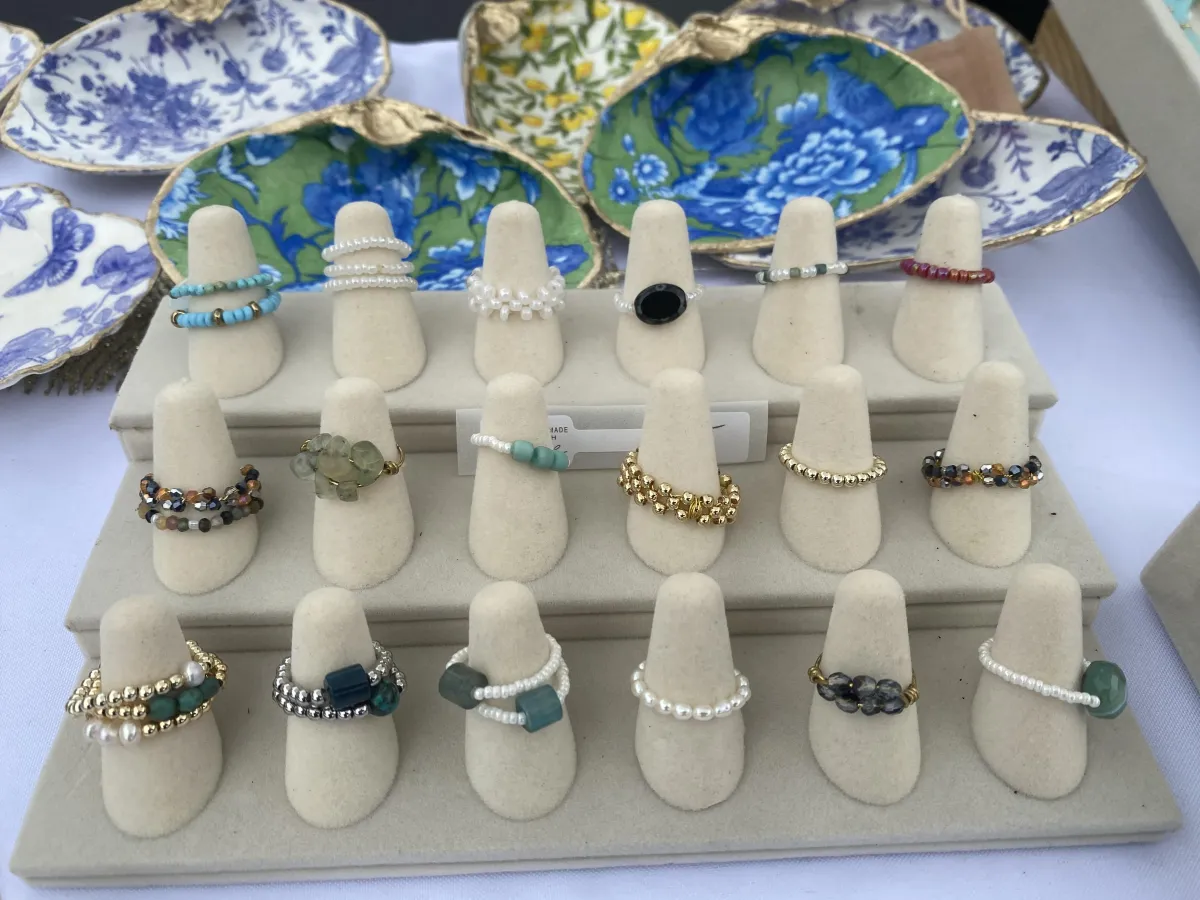
Beaded Ring
A beaded ring is a handmade piece of jewellery formed by stringing beads into a circular shape to fit the finger. Beads may be made of glass, gemstones, metal, wood, or shell, and are typically strung on elastic, wire, or thread.
Design and Techniques
Beaded rings range from simple single-strand styles to intricate woven patterns. Common techniques include peyote stitch, right-angle weave, and wire wrapping. Their artisanal charm and affordability make them popular at craft fairs and artisan shops.
Fashion and Care
Beaded rings gained notable popularity in the 1990s and 2000s and remain fashionable as customizable, stackable accessories. To maintain their condition, they should be kept dry and handled gently due to their delicate construction.
---
Ring
A ring is a circular band, usually made of metal, worn as ornamental jewellery. By default the term refers to finger rings; when worn on other body parts, a modifier is used (e.g., earrings, arm rings, toe rings). Rings fit snugly around the body part they adorn, distinguishing them from loose-fitting ornaments like bracelets.
Materials and Decoration
Rings can be crafted from wood, bone, stone, metal, glass, jade, gemstone, or plastic, and may be set with gemstones such as diamonds, rubies, sapphires, or emeralds, or with other decorative stones or glass.
Symbolism and Uses
Beyond decoration or displays of wealth, rings have long served symbolic roles. They can signify marriage, achievement, status or authority, or membership in organizations. Some rings feature insignia for impressing wax seals, while others include small compartments for concealed objects.
---
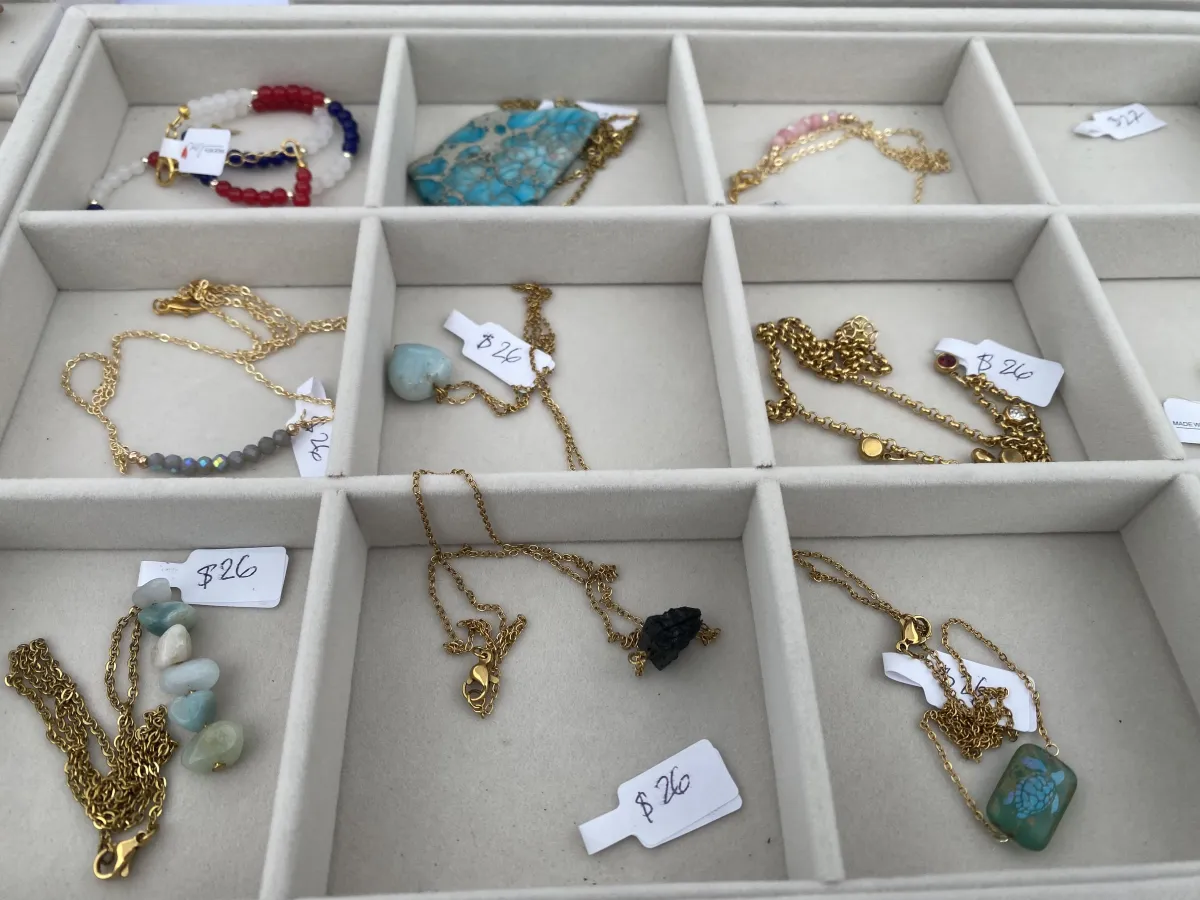
---
Pearls
A pearl is a hard, lustrous object produced within the soft tissue (mantle) of a living shelled mollusk or, more rarely, other animals such as fossil conulariids. Like a mollusk’s shell, a pearl consists primarily of calcium carbonate—mainly aragonite or a mix of aragonite and calcite—arranged in minute concentric crystalline layers.
Types and Formation
The most prized pearls form spontaneously in the wild and are known as natural pearls. These are rare and historically valuable. By contrast, cultured pearls, which make up the majority of pearls sold today, are farmed from pearl oysters or freshwater mussels. Imitation pearls, usually made from glass or plastic, are common in inexpensive jewelry.
Characteristics and Uses
Pearls of gem quality are typically nacreous and iridescent, similar to the inner shell of the mollusk. Although most mollusks can produce so-called calcareous concretions, many lack the luster or spherical form of gem-quality pearls and thus have little commercial value.
Pearls have long been valued as gemstones and metaphors for rarity and beauty. Historically they adorned clothing and have been ground for use in cosmetics, medicine, and paint.
---
Beads
A bead is a small, decorative object with a hole for threading, made in a wide range of materials—including stone, bone, shell, glass, plastic, wood, and pearl—and in sizes from under 1 mm to over 1 cm.
Historical Significance
Beads are among the earliest forms of jewellery. A pair of beads made from Nassarius sea snail shells, dated to approximately 100,000 years ago, are considered the oldest known examples.
Beadwork
Beadwork is the art or craft of creating items with beads, whether woven with thread, strung on flexible wire, or affixed to fabric or clay. Designs can range from minimal patterns to elaborate full-surface ornamentation.
Glassworking
Most glass beads are mass-produced from molten glass pressed into molds. Plastic beads are produced similarly.
A smaller and more expensive category, including glass and lead-crystal beads, is cut into precise facets—formerly by hand but now largely by precision machinery. Fire-polished beads, a less costly alternative, are molded, ground into facets, and briefly reheated to smooth surface irregularities.
Common Types
* Square beads: Used as spacers or as the sole element of necklaces, including rosaries and beachwear jewellery.
* Seed beads: Small, uniformly shaped spherical or tubular beads, widely used in loom and off-loom bead weaving.
* Vintage beads: At least 25 years old, found in materials such as lucite, crystal, and metal.
* Czech glass beads: Produced in Jablonec nad Nisou, Czech Republic, with a tradition dating to the 14th century and noted for quality workmanship.
Surface Patterns
Glass and crystal beads can be surface-treated by etching or by applying color layers. Coatings such as Aurora Borealis (AB) create iridescent effects, while others (e.g., vitrail, moonlight, dorado, satin, star shine, heliotrope) provide alternative finishes.
Faux and Natural Alternatives
Faux beads imitate precious materials such as pearls, gemstones, metals, or ivory. Tagua nuts are used as a sustainable substitute for natural ivory.
Ethnic and Traditional Beads
Examples include Tibetan Dzi beads and Rudraksha beads (for Buddhist and Hindu malas), magatama (Japan), cinnabar beads (China), wampum (Northeastern Native American tribes), Job’s tears (seed beads used in the Southeast United States), and heishe (shell or stone beads of the Kewa Pueblo in New Mexico).
Shell Necklaces
Aboriginal Tasmanian women have produced maireener shell necklaces for at least 2,600 years. Contemporary artisans such as Palawa elder Lola Greeno help sustain this tradition despite declining shell supplies.
---
Jewellery Design
Jewellery design is the art or profession of creating ornamental pieces such as rings, necklaces, and bracelets. This practice dates back at least 7,000 years, with early examples found in the Indus Valley, Mesopotamia, and Egypt.
Techniques and Evolution
Design concepts are traditionally hand-drawn, then converted into technical drawings or directly into wax or metal. Increasingly, designers use computer-aided design (CAD) and 3D printing to create models for casting.
Historically, 24 karat gold was favored for availability and workability. Early jewellery incorporated beads, and the discovery of gem-cutting techniques (beginning with Theophilus Presbyter’s documented work in the 11th–12th centuries) advanced the art. By the 14th century, lapidary methods enabled cabochons and cameos. Techniques such as enameling and repoussé became common for decorative and ceremonial commissions, influencing later styles including the Baroque.
---
Synthetic Gemstones
Many gemstones are now laboratory-grown to meet jewelry and industrial demands. Not all stones are economically feasible to synthesize, but several are common.
Synthetic Corundum
Synthetic corundum, including ruby (red) and sapphire (other colors), was first produced by Auguste Verneuil using the flame-fusion process in 1902. Today, corundum is typically made by flame-fusion, with flux and hydrothermal growth also used.
Synthetic Beryl
Emerald, the most common synthetic beryl, can be produced via flux growth and hydrothermal growth. Other beryl colors—yellow, red, blue—are possible but rare.
Synthetic Quartz
Varieties such as citrine, rose quartz, and amethyst are synthesized for both ornamental and industrial uses. Quartz’s ability to generate an electric current under pressure makes it essential for watches, clocks, and oscillators.
Synthetic Spinel
Initially discovered accidentally, synthetic spinel can be created in virtually any color, making it useful for imitating natural gemstones. It is commonly produced via flux and hydrothermal growth.
---
Formation and Occurrence
Aquamarine forms over millions of years in granite pegmatites and hydrothermal veins, processes associated with Precambrian rocks. It occurs in many countries worldwide and is widely used in jewellery and ornamental decoration.
Notable Examples
Famous aquamarines include:
The *Dom Pedro**
The *Roosevelt Aquamarine**
The *Hirsch Aquamarine**
* Queen Elizabeth II’s aquamarine tiara
* Meghan Markle’s aquamarine ring
The *Schlumberger bow brooch**
---
Birthstone
A birthstone is a gemstone associated with a person’s birth period, most often by month or zodiac sign. Birthstones are typically incorporated into rings, necklaces, pendants, and other personal jewellery.
---
Aquamarine
Aquamarine is a pale-blue to light-green variety of beryl with a hexagonal crystal system. It is generally transparent to translucent and is considered relatively common and accessible compared with other beryl gemstones such as emerald.

Gold
Gold is a chemical element with the symbol Au (from Latin aurum) and atomic number 79. In its pure form it is a bright, slightly orange–yellow, dense, soft, malleable, and ductile metal. Gold is a transition metal and a group 11 element, belonging to the family of noble metals. It is one of the least reactive chemical elements, ranking second only to platinum in the reactivity series. Gold is solid under standard conditions.
Occurrence
Gold often occurs in free elemental (native) form as nuggets or grains in rocks, veins, and alluvial deposits. It can also exist in a solid solution with silver (known as electrum), be naturally alloyed with metals such as copper and palladium, or be present as mineral inclusions in pyrite. Less commonly, gold occurs as chemical compounds, often combined with tellurium as gold tellurides.
Chemical Properties
Gold is resistant to most acids, but it dissolves in aqua regia (a mixture of nitric and hydrochloric acids) to form a soluble tetrachloroaurate anion. It is insoluble in nitric acid alone—a property historically used in refining and testing gold, giving rise to the term acid test.
Gold also dissolves in alkaline cyanide solutions, which is important for mining and electroplating, and forms amalgams when mixed with mercury, acting as a solute without chemical reaction.
---
Stone Jewellery
Stone jewellery refers to ornaments made with natural or organic stones and has been valued for thousands of years for its beauty, cultural symbolism, and craftsmanship. Stones are traditionally grouped by rarity, value, and composition.
Precious Stones
The most highly valued gems, often called the “**big four**,” include:
* Diamond – celebrated for clarity, brilliance, and hardness; a symbol of eternal love.
* Ruby – vivid red, representing passion, strength, and vitality.
* Sapphire – famed for blue hues but found in many colours; linked to wisdom and loyalty.
* Emerald – deep green, associated with rebirth, prosperity, and romance.
These gems have been used for crowns, engagement rings, and heirloom jewellery for centuries.
Semi-Precious Stones
More abundant but still prized for beauty and symbolism, these include:
* Amethyst – purple quartz, symbolizing clarity and calm.
* Garnet – found in many colours, representing energy and protection.
* Peridot – lime-green, linked to vitality and renewal.
* Aquamarine – sea-blue, symbolizing courage and serenity.
* Turquoise – sky-blue to green, long used as a protective and lucky charm.
Semi-precious stones are used in both fine jewellery and everyday designs.
Organic Materials
Some decorative stones form from biological or natural processes:
* Pearl – produced by oysters, representing purity and elegance.
* Amber – fossilized tree resin, sometimes preserving ancient inclusions.
* Coral – marine in origin, valued for red and pink tones.
* Jet – fossilized wood, historically used in mourning jewellery.
These materials carry cultural and historical significance.
Decorative Stones
Typically opaque but highly coloured, these stones are valued for patterns and artistic appeal:
* Malachite – banded green with striking patterns.
* Lapis lazuli – deep blue with gold flecks, treasured since antiquity.
* Onyx – black or banded, used for bold designs.
* Aventurine – shimmering quartz, usually green, symbolizing prosperity.
Such stones are often polished into cabochons, beads, or carvings for distinctive jewellery.
---
Materials for Beadmaking
Natural Materials
Beads have long been made from natural substances, both organic and inorganic, often enhanced by dyes or irradiation.
* Organic materials include bone, horn, ivory, seeds (such as tagua nuts), animal shells, wood, amber, jet, and pearls (the latter now widely available due to modern pearl-culturing).
* Inorganic materials include gemstones, common minerals, and metals. Some precious metals occur in pure forms; natural alloys such as electrum are also used.
Synthetic Materials
The oldest surviving synthetic bead materials are ceramics, such as pottery and glass. Ancient alloys like bronze and brass were also used, though their susceptibility to oxidation limits their preservation.
Modern beadmaking uses numerous glass varieties, including lead crystal, which has a high lead-oxide content that increases its refractive index. Many glass types are inseparable from their manufacturing process.
Plastic Beads
Plastic beads are common in both craft and toy markets. Small fusible plastic beads can be arranged on a pegboard to form designs and fused with a clothes iron. These beads come in a wide range of colors and transparencies, including glow-in-the-dark and glitter varieties.
The pegboard bead craft was invented in Sweden in the early 1960s by Gunnar Knutsson (patent filed 1962, granted 1967). Early beads, sometimes called Indian beads, were sewn into ribbons before fusion methods were developed.
Brands and sizes include:
* Hama – mini (2 mm), midi (5 mm), and maxi (10 mm)
* Perler – classic (5 mm) and biggie (10 mm)
* Pyssla (IKEA) – single size (5 mm)
---
Design Integration
Depending on the design, the pendant may be integral to the necklace or a clearly separate ornament that can be removed or interchanged.
Pendant
A pendant is a loose-hanging piece of jewellery attached by a small loop to a necklace, forming what is often called a pendant necklace. A pendant earring features a similar hanging element. The term derives from the Latin pendere and Old French pendr, meaning to hang down. In modern French, pendant is the gerund of pendre (“to hang”) and also means during.
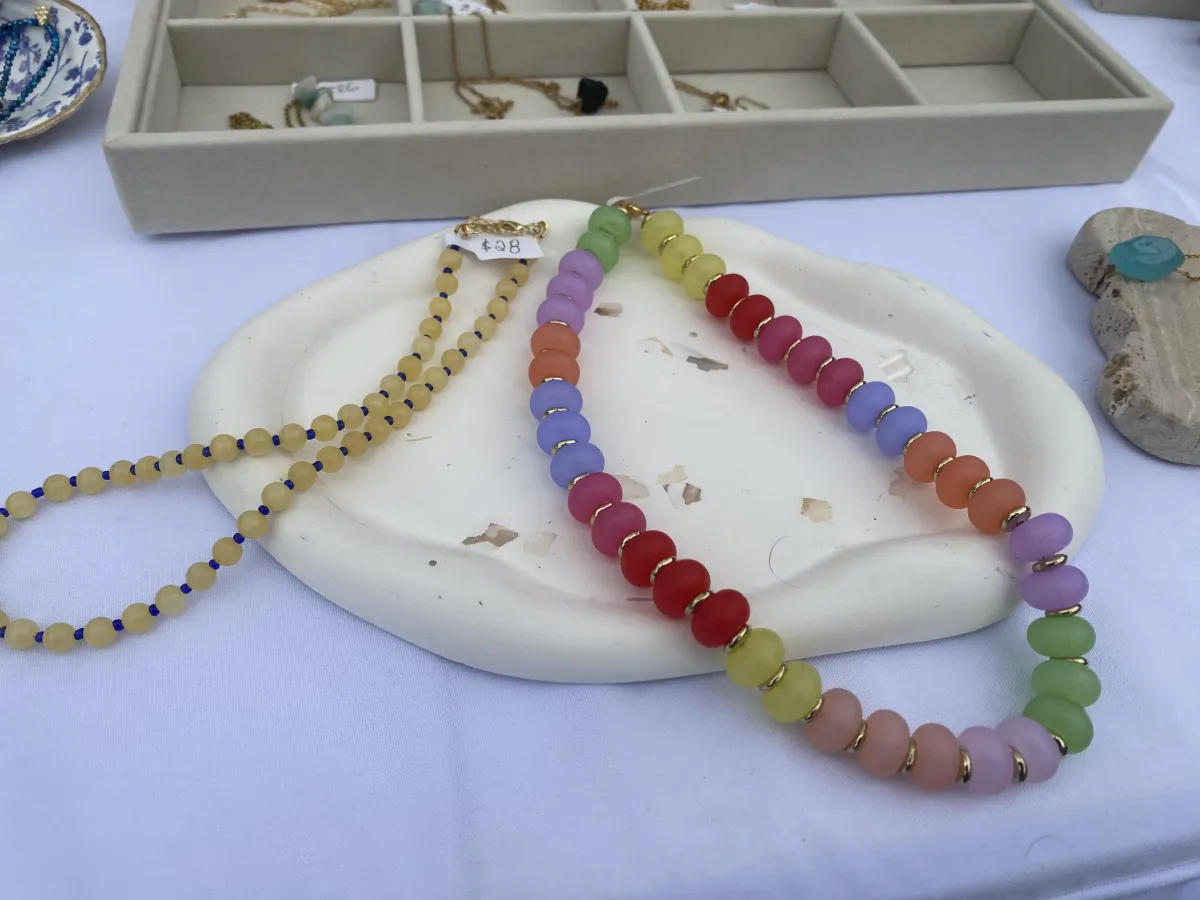
Old Town San Clemente Market
Local. Handmade. Heartfelt. Join us for a community-driven farmer's market in the heart of San Clemente.

